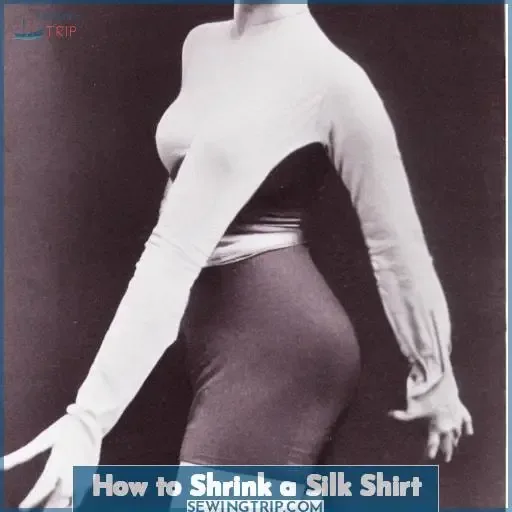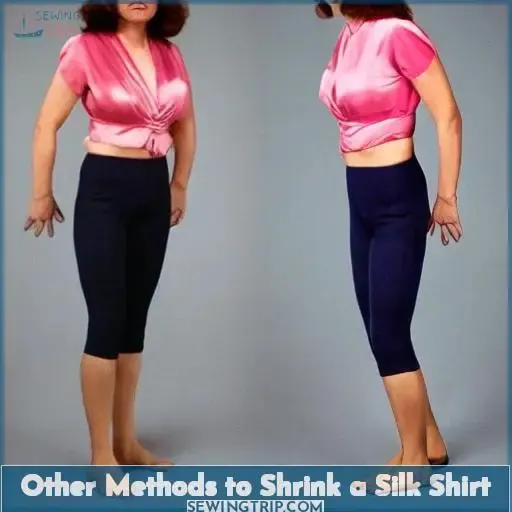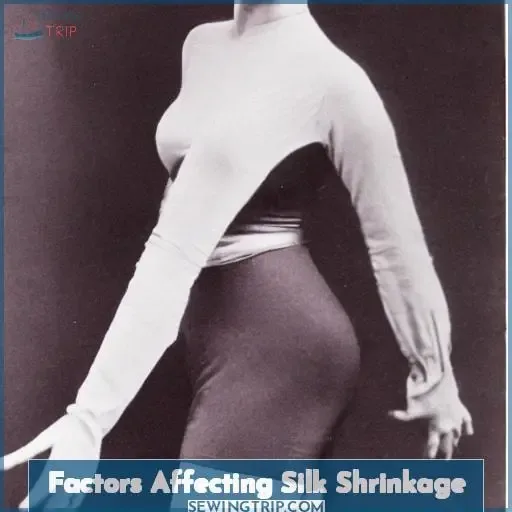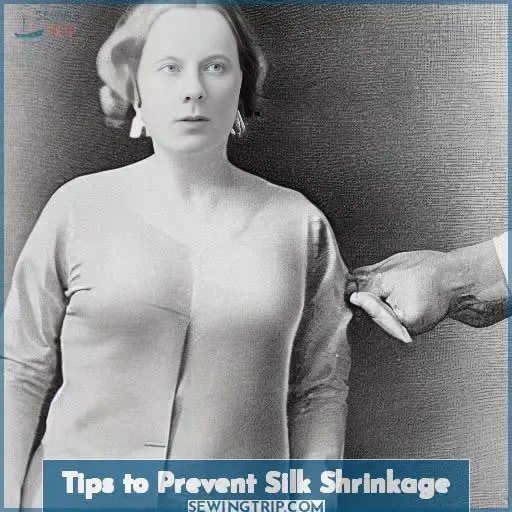This site is supported by our readers. We may earn a commission, at no cost to you, if you purchase through links.
Shrinking a silk shirt can be tricky. If done incorrectly, it could cause irreparable damage. To prevent that, you need to understand how best to go about it. In this article, we’ll explore all the methods available for shrinking silk, plus tips and tricks to prevent shrinkage in future garments. After laundering or ironing, they may not turn out exactly right. So, use this info to make sure you get the best results.
Table Of Contents
Understanding Silk Fabric
To successfully alter a silk shirt, it’s important to understand the unique properties of this delicate fabric. Silk has been coveted for centuries due to its natural sheen and luxurious feel. It’s a lightweight material that can be woven into different patterns or dyed various colors with special dyeing techniques.
Furthermore, there are many ways to soften and care for silk clothing. These include dry cleaning or hand washing in lukewarm water instead of hot, as heat will cause shrinkage of the fabric fibers.
Understanding these qualities allows you to appreciate why certain weaving patterns, dyeing techniques, softening processes or care instructions should be taken into consideration when shrinking your own silk clothing items.
The Best Method to Shrink a Silk Shirt
To determine the best way to modify a silk shirt, it’s important to investigate what types of fabric are more resistant or vulnerable to heat and why. Silk is not very resilient when exposed to high temperatures and should be treated with caution due its delicate nature.
The safest method for shrinking a silk shirt is air drying on low heat settings. If further shrinkage is desired, pre-treating the garment with cold water prior washing on gentle cycle can help minimize damage caused by hot water setting in combination with high heat setting from the dryer.
Handwashing can also prove effective as long as you follow all steps carefully and avoid submerging your garments into boiling water directly from stovetop burner or any other direct source of extreme temperature that could cause irreversible damages such as burning marks on fibers which may result in permanent alteration of texture beyond repairable state without professional assistance like tailoring for example.
Other Methods to Shrink a Silk Shirt
Shrinking a silk shirt requires careful consideration as the fabric is sensitive to heat. You can shrink it using various methods, such as hot water and dryer, ironing, dry cleaning or steaming. It’s important to understand each method comes with its own risks and rewards; take time to research which one works best for you before attempting it.
It’s crucial to get it right, so take your time. Contractions can help make the text flow better.
Method 1: Hot Water and Dryer
If you’re looking for a quick and easy method to modify your silk shirt, try using hot water and a dryer setting! It works best on heat-resistant natural fibers, like cotton. Pre-treat the garment with an absorbent towel to protect it from high temperature damage.
Put the garment inside out into the washing machine on its hottest setting. Then, transfer it straight to the tumble dryer set at ‘high’. Once it’s completely dried, remove it immediately so no further shrinkage occurs. You should get a perfect fit every time!
When washing silk garments, always use cold water. Avoid leaving them in direct sunlight, or storing them near sources of heat.
Method 2: Ironing
Ironing out your silk shirt is a great way to create the perfect fit without the risk of damaging its delicate fabric. Turn it inside out and lay it evenly on an ironing board with the dull backside facing up. Use a spray bottle filled with water to add moisture to the area that needs shrinking, and cover it with a cotton press cloth before turning on the iron at its highest heat setting. Hand press lightly for heat distribution, and repeat until the desired level of shrinkage has been achieved. Don’t use high temperatures; they can easily ruin silk fabrics, which are very sensitive to extreme heats!
Method 3: Dry Cleaning
If you want to shrink your silk garment without risking damage, taking it to the dry cleaner is a safe option. Dry cleaning can be done by professionals who understand how to properly treat delicate fabrics like silk. They’ll use an iron at a specific temp and adjust the heat based on the fabric’s thickness. They may also factor in laundering habits when determining which treatment works best.
To ensure quality results, always wash new garments in cold water with mild detergent before taking them to a professional cleaner for shrinking or alteration services. This way any dirt or stains are removed before proper care is applied, so no additional damage is caused during the process.
Method 4: Steamer
Using a steamer is an easy and gentle way to tailor your delicate silk shirt in the comfort of your own home. Unlike other methods, using a steamer doesn’t require direct contact with the fabric, reducing the risk of damage or creasing. To use this method, fill up the water tank with clean water and hang up your shirt where you have enough room to maneuver it around. Use a spray bottle filled with lukewarm water to add moisture evenly throughout areas that need shrinking before starting on each section one at a time until desired level of shrinkage is achieved.
Pros:
- Gentle process
- Doesn’t cause dye fading or color bleeding
- Reduces allergy-prone reactions due no chemical residue left behind
Cons:
- Takes longer than boiling
- Expensive compared to other options
- Not as effective as ironing
To ensure that you don’t overdo any step, keep track by taking measurements before beginning. Avoid high temperatures which could burn fabrics and lead to irreversible damage (such as discoloration). Don’t expose clothing materials too long under UV rays, as they will fade quickly, especially if exposed directly onto dyed surfaces.
Factors Affecting Silk Shrinkage
You might think shrinking a silk shirt’s easy, but several factors affect how much it’ll shrink. Water temperature used when washing, fabric quality, surface area and stress on the fabric all play an important role. To ensure the garment shrinks as desired without damage to its texture or color, consider these key points before attempting any shrinking methods.
Factor 1: Water Temperature
When shrinking a silk shirt, it is important to be mindful of the water temperature as too much heat can permanently damage your fabric. Use lukewarm temperature water with moderate soap quality or chemical agents. Washing machines can be used on high heat settings, but this could reduce the garment’s life span significantly. Blow dryers or irons at higher temperatures should only be used if you’re willing to risk further shrinkage; otherwise, hang drying in sunlight works better without damaging it. Following these methods will help you shrink a silk shirt correctly without heat exposure damaging it.
Factor 2: Fabric Quality
You should pay close attention to fabric quality when trying to size down a garment. Different fabrics shrink differently and need different levels of heat. Higher thread count silk with tight weaves like Silk Satin or Silk Broadcloth are less likely to shrink than those with looser weaves like Crepe de Chine. The dyeing process and fiber composition also play a role in how much a shirt can be shrunk without damage. Laundering techniques used on Silk Pillowcase may differ from those used to shrink silk shirts due to its delicate nature. Understanding why fabrics shrink is key to shrinking clothing without damaging it or over-shrinking it with too much heat.
Factor 3: Fabric’s Surface Area
When it comes to sizing down your clothing, the surface area of the fabric is an important factor to consider. Different types of silk, such as silk satin or broadcloth, have a tight weave that can resist shrinkage when machine washed on hot settings or hand-washed with great care.
Loose weaves, though, are more likely to shrink without direct sunlight and heat setting, along with light ironing using steam pressing techniques.
Before attempting any shrinking process, be sure to check each garment’s care label for instructions; otherwise, you may end up damaging your beautiful piece of clothing!
Factor 4: Stress on the Fabric
During the manufacturing process, fabrics are often put through a lot of stress. To start shrinking a silk shirt using any type of heat, take note of the water temperature used on the fabric label, its quality, and surface area. Steam shrinkage is an option, but don’t overdo it or risk scorching. Dry cleaning with free hand method may work better for delicate silks, while UV light press start is best for human hair wigs.
Different types of heat require varied levels of caution. Understand what kind suits each fabric before beginning and follow all directions precisely for perfect results! Just remember: everything in moderation!
Tips to Prevent Silk Shrinkage
To help keep your silk shirt looking great, follow a few simple tips to prevent it from shrinking. Caring for silk should always be done with care; use gentle washing techniques and never wash in hot water, as this will cause damage. Avoid leaving the garment out in direct sunlight or other extreme weather conditions, as these can affect shrinkage.
When ironing, set the temperature at low to avoid burning or damaging the fabric. Use mild detergents specifically created for handwashing, instead of harsh laundry soap that could strip away color dyes over time. This is one of the most effective ways to preserve fabrics like silk while keeping them clean.
To ensure specific parts of your shirt shrink just enough, but not too much, an iron may be used. Cover areas with cotton press cloths before pressing down gently where desired until reaching desired size results. This method helps target more precise measurements than those obtained through boiling water, which could have unpredictable results if handled improperly.
Frequently Asked Questions (FAQs)
How much can I expect a silk shirt to shrink?
Do you ever feel like your silk shirts are just a bit too big? Well, you’re in luck! With the right technique and some patience, you can shrink it down to fit perfectly. But be warned: shrinking a silk garment takes care and skill depending on its fabric weight, dye type, etc.
Hand washing or air drying with pre-washing can help reduce excess water from the area that needs shrinking. It’s key to understand how much each fabric shrinks; e.g. high-quality cotton can shrink 5%-7%, while lower quality fabrics may go up to 7%-10%.
If you want perfect fitting clothes without sacrificing style, why not give it a try? With careful practice comes mastery over any task!
Is it possible to shrink a silk shirt without damaging it?
Shrinking a silk shirt is possible, but tricky and may damage the fabric. The most popular method is using the washing machine and dryer on hot settings. Boiling water, an iron or steamer can also be used, but with caution, if greater shrinkage is desired. It’s important to use clean water, as high temperatures can easily cause irreversible damage to silk fibers. To avoid ruining your favorite piece, understand why fabrics shrink, and follow Priya Raj’s methods for specific fabrics.
What temperature should I use when shrinking a silk shirt?
When shrinking a silk shirt, use temperatures no higher than 30C (86F). Hand washing in warm water and air drying or dry cleaning is recommended for delicate fabrics like silk. But if you use a washing machine or ironing board with heat settings, don’t exceed 40C (104F). Too much heat can damage quality, so for accurate results with pre-shrunken garments like silk shirts and blazers from Old Bull Lee & Sauce, stay within that limit.
How do I shrink a silk shirt with an iron?
Shrinking a silk shirt with an iron is the best way to achieve desired results without damaging the fabric. Turn it inside out and lay it evenly on an ironing board. Use a spray bottle filled with water to add moisture to the area you wish to shrink. Cover it with a cotton press cloth and set your iron at its highest temperature. Hand press in that specific spot until you get the desired level of shrinkage.
Ironing technique depends on how much surface area needs shrinking, so don’t follow any washing instructions or natural dyes from laundering habits if style preferences are different than expected. Heat is the only surefire way for DIY shrinking!
Is it possible to shrink a shirt larger than its original size?
It is possible to shrink a shirt larger than its original size, depending on the type of silk cloth and the method used. Natural fibers such as tissue silk cloth can be made to stretch through cold soaks with detergent and water. Dry heat like an iron or blow dryer can also work if done carefully, but higher temperatures can cause damage. Dr Karen Iveson suggests air drying or using a steamer at lower settings to increase fabric stretch without causing harm. Understand which type of silk cloth you’re working with before attempting any manipulation; otherwise you risk irreparable damage.
Conclusion
In conclusion, understanding the nature of silk fabric and the factors that affect its shrinkage is key to successfully shrinking a silk shirt. Shrinking a silk shirt requires the right technique and level of heat.
For best results, it’s recommended to use a hot water and dryer or ironing method, as these are the least damaging ways to shrink a silk shirt. Factors such as water temperature, fabric quality, surface area, and stress on the fabric should also be considered.
To ensure the shirt doesn’t shrink, always wash in cold water and air dry. Following these steps will keep the shirt in its original shape and size.











